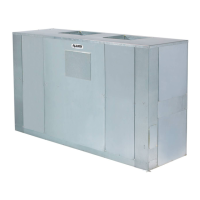Page 114
C12 DIAGRAM WITH D8 DIAGRAM
Honeywell T7300 Thermostat with ThreePosition Economizer
7-C12 Section with D8 Section
The Honeywell T7300 programmable thermostat allows GCS16 units without economizer to
automatically setback or setup setpoints for unoccupied periods as well as control setpoints
more precisely than electromechanical thermostats. With the economizer added, the T7300 is
capable of directly controlling the economizer and can directly control morning warmup.
NOTE - In order to understand how these optional controls affect the operation of the GCS16,
you must first understand how all GCS16 components work. Refer to the operation se
quence for basic unit operation.
NOTE - These thermostats have a builtin clock for controlling setback. Optional time clock
CMC3-1, night thermostat and night relay kit are not needed and are not compatible.
Operation Sequence:
1- The GCS16 with T7300 is designed so that the fan switch in the thermostat should be left in the
ON mode at all times. This allows the blower to be controlled by terminal G in the thermostat.
The blower operates continuously during occupied periods and intermittently during unoccu
pied periods.
2- During a heating demand when the building is not occupied, the blower is activated only when
a heating demand passes through relay K25 in the GCS16. During a cooling demand when the
building is not occupied, the blower is activated through terminal G in the thermostat.
Heating:
3- Heating demand W1 from the T7300 energizes the heat section of the GCS16 directly. When
relay K13 is energized to start the combustion air blower, contacts K13-2 close. When con
tacts K13-2 close, 24VAC is passed to T7300 terminal A1. When A1 is energized, A2 is ener
gized and 24VAC is passed to terminal X on the enthalpy control and damper motor. Outdoor
dampers open to mid (minimum) position.
I. Enthalpy Control in Low Position (outside air can be used for cooling).
1st stage cool (all models):
4- Initial cooling demand Y1 is sent to enthalpy control A6 terminal 1.
5- Enthalpy control A6 has determined that outside air can be used for cooling and has switched
1K and 2K internally.
6- Cooling demand is routed through enthalpy control terminal 6 and through discharge air ther
mostat S13 to enthalpy control terminal D and damper motor terminal D.
7- When 24VAC is applied across terminals D and T of damper motor, the damper motor ener
gizes and outdoor dampers open fully. First stage cooling is provided by outdoor air.
2nd stage cool (all models):
8- Economizer outdoor air dampers remain open.
9- Additional cooling demand is routed from thermostat Y2 through enthalpy control terminals 3
and 5 to energize the compressor. The compressor provides all additional cooling demand.
II. Enthalpy Control in High Position (outside air cannot be used for cooling).
10- Cooling demand is sent from thermostat terminal Y1 through enthalpy control terminals 1 and
2 and through enthalpy control terminal 5 to energize the compressor. The compressor han
dles all cooling demand.
11- Simultaneously, blower demand energizes relay K3 in the unit. Contacts K3-2 close to ener
gize terminal A1 on the T7300.
12- T7300 has determined that minimum position is appropriate (day mode) and terminal A2 is
energized. A2 energizes terminal X on enthalpy control A6 and damper motor B7. When
24VAC is applied across terminals X and T of damper motor, the damper motor energizes and
outdoor dampers open to mid (minimum) position.
Night Setback (optional field installed)
13- Night setback and morning warm-up are controlled directly by the T7300. During night set
back, the T7300 changes to unoccupied setpoints. Operation sequence does not change.
Outdoor dampers are held closed by T7300 terminal A2.
14- During morning warm-up (first heat demand of the day - after night setback) T7300 terminal A2
remains deenergized and the outdoor dampers remain closed.

